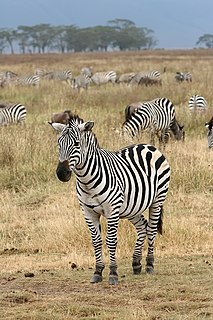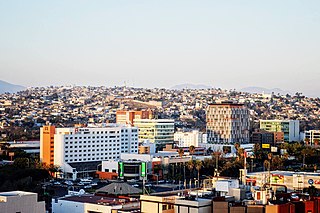This article concerns systems of transport in Lesotho. As a landlocked country, Lesotho has no seaports or harbours, but does have road, air transport, and limited rail infrastructure.
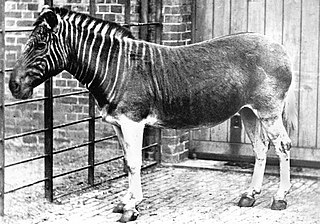
The quagga was a plains zebra that lived in South Africa until becoming extinct late in the 19th century. It was long thought to be a distinct species, but early genetic studies have supported it being a subspecies of plains zebra. A more recent study suggested that it was merely the southernmost ecotype of the species. The name was derived from its call, which sounded like "kwa-ha-ha".

A zebra crossing is a type of pedestrian crossing used in many places around the world. Its distinguishing feature is alternating dark and light stripes on the road surface, resembling the coat of a zebra. A zebra crossing typically gives priority to pedestrians.

A zebroid is the offspring of any cross between a zebra and any other equine: essentially, a zebra hybrid. In most cases, the sire is a zebra stallion. Offspring of a donkey sire and zebra dam, called a zebra hinny, or donkra, and offspring of a male horse and a female zebra called a hebra do exist, but are rare and are usually sterile and infertile. Zebroids have been bred since the 19th century. Charles Darwin noted several zebra hybrids in his works.
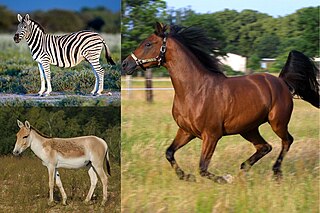
Equus is a genus of mammals in the family Equidae, which includes horses, donkeys, and zebras. Within Equidae, Equus is the only recognized extant genus, comprising seven living species. The term equine refers to any member of this genus, including horses. Like Equidae more broadly, Equus has numerous extinct species known only from fossils. The genus most likely originated in North America and spread quickly to the Old World. Equines are odd-toed ungulates with slender legs, long heads, relatively long necks, manes, and long tails. All species are herbivorous, and mostly grazers, with simpler digestive systems than ruminants, but able to subsist on lower-quality vegetation.
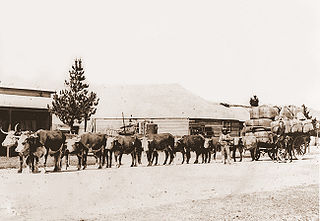
A working animal is an animal, usually domesticated, that is kept by humans and trained to perform tasks. They may be close members of the family, such as guide dogs or other assistance dogs, or they may be animals trained to provide tractive force, such as draft horses or logging elephants. The latter types of animals are called draft animals or beasts of burden. Most working animals are either service animals or draft animals. They may also be used for milking or herding, jobs that require human training to encourage the animal to cooperate. Some, at the end of their working lives, may also be used for meat or other products such as leather.

Custer State Park is a South Dakota State Park and wildlife reserve in the Black Hills, United States. The park is South Dakota's largest and first state park, named after Lt. Colonel George Armstrong Custer. The area originally started out as sixteen sections, but was later changed into one block of land because of the challenges of the terrain. The park began to grow rapidly in the 1920s and gained new land. During the 1930s the Civilian Conservation Corps built miles of roads, laid out parks and campgrounds, and built three dams that set up a future of water recreation at the park. In 1964 an additional 22,900 acres (93 km2) were added to the park. The park covers an area of over 71,000 acres (287 km2) of hilly terrain and is home to many wild animals.

A bullock cart or ox cart is a two-wheeled or four-wheeled vehicle pulled by oxen. It is a means of transportation used since ancient times in many parts of the world. They are still used today where modern vehicles are too expensive or the infrastructure favor them.

Avenida Revolución is the tourist center in Tijuana, Baja California, México. It is a main thoroughfare of the historic downtown of Tijuana, officially called the Zona Centro, which forms part of the Delegación Centro or Central Borough of Tijuana.
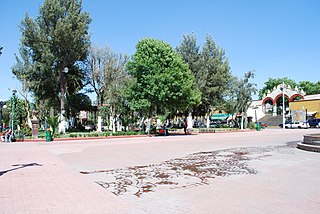
Otumba or Otumba de Gómez Farías is a town and municipality located in the northeast of the State of Mexico, just northeast of Mexico City. Historically, this area is best known as the site of the Battle of Otumba and as an important crossroads during the colonial period where incoming viceroys ceremoniously were handed power by their predecessors. Today, it is a rural municipality undergoing changes as urbanization arrives here from the Mexico City area. However, one element from the past that is still remembered is that of burros or donkeys. During the colonial period, Otumba was an important market for the animals, and they are still culturally important. Each year, the municipality sponsors a Feria de Burros or Donkey Fair, where the animals star in fashion shows, costume contests, and races. There is also a donkey sanctuary for unwanted animals.
Animal-borne bomb attacks are the use of animals as delivery systems for explosives. The explosives are strapped to a pack animal such as a horse, mule or donkey. The pack animal may be set off in a crowd.

Agua Caliente is an historic entertainment center and present day district of Tijuana, Baja California, at the southeastern end of the Centro borough. The Agua Caliente Tourist Complex formed in the late 1920s along Agua Caliente Boulevard when a road was built that led from the historic Rio Zone to a natural hot springs two miles up the Tijuana River Valley. Paramount icons of Tijuana developed in Agua Caliente such as the Agua Caliente Casino and Hotel and the Agua Caliente Racetrack. Today Agua Caliente is one of Tijuana's paramount tourist centers and the location of some of the city's most affluent neighborhoods.

Tourism is an important industry in Metro Manila, Philippines. In 2012, the city and region welcomed 974,379 overnight visitors. As the main gateway to the Philippines' many destinations, the city is visited by the majority of international tourists to the country registering a total of 3,139,756 arrivals in 2012. Global Blue ranked Manila eleventh in its "Best Shopping Destinations" in Asia. The city is ranked tenth in MasterCard's global top 20 fastest growing cities for international visitors from 2009-2013.

The Miranda donkey, Portuguese: 'Burro de Miranda', is an autochthonous donkey breed from the Terra de Miranda region of northeast Portugal.
Equid hybrids, also called hybrid equines, are created from the crossing of members from the horse family such as a horse, donkey and zebra.


